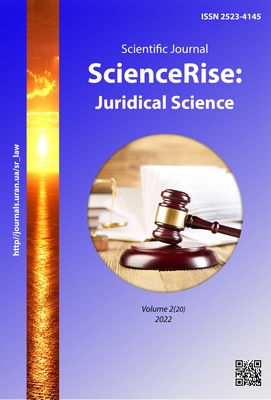Interaction of police officers with medical workers in providing premedical care to victims in case of thermal, electrical, solar and chemical burns in the conditions of the established martial law
DOI:
https://doi.org/10.15587/2523-4153.2022.258674Keywords:
rescuers, police, burns and their types, severity of damage, victims, assessment of the victim state, premedical care, algorithm of rescue operations, features of transportation, contraindications, martial lawAbstract
The paper considers an urgent problem - providing premedical care to victims in case of various burns by rescuers (police, specialists of emergency medical services and disaster medicine, the State Emergency Service, etc.) in the conditions of hostilities during the full-scale invasion of the aggressor country's troops.
The medical aspect of the concept of burns is revealed, their types (thermal, electric, chemical, solar) are characterized and the signs of the existing degrees of severity of the lesion depending on the depth of damage to human tissues are given. The procedure of providing premedical care by rescuers to victims of each of the above mentioned types of injuries is described.
Attention is paid to the peculiarities of transportation of victims with thermal burns: 1) compliance of the reception department, if possible, to the nature of the damage, especially in case of damage to the respiratory system or suspicion of serious or explosive injury; 2) the use, if possible, of air evacuation in case of remote location of the receiving department of the medical institution or if the victim's airways require surgical interventions that are not available at the pre-hospital level due to limited EMC capabilities; 3) immediate delivery of a person to the burn centre with an area of burns more than 10 % of the body and which are extended to the extremities, genitals, face and/or circular burns.
Taking into account the use of phosphorous bombs by aircraft of RF in the conditions of full-scale war on the territory of Ukraine, the peculiarities of chemical burns due to the action of white phosphorus on the human body are considered, and the algorithm of premedical care to victims of these lesions is revealed.
Emphasis is placed on the need to comply with contraindications in providing premedical care to victims of burns (it is strictly forbidden to use ice, oil, flour, aloe juice and other folk remedies; apply gels, ointments, creams, alcohol-based drugs to the wound for pain relief etc.)
References
- Pro pravovyi rezhym voiennoho stanu (2022). Zakon Ukrainy. No. 389-VIII. 12.05.2015. Available at: https://zakon.rada.gov.ua/laws/show/389-19#Text Last accessed: 22.03.2022
- Pro ekstrenu medychnu dopomohu (2012). Zakon Ukrainy No. 5081-VI. 05.07.2012. Available at: https://zakon.rada.gov.ua/laws/show/5081-17/page1#Text Last accessed: 20.02.2022
- Pro Natsionalnu politsiiu (2015). Zakon Ukrainy No. 580-VIII. 02.07.2015. Available at: https://zakon.rada.gov.ua/laws/main/580-19 Last accessed: 22.03.2022
- Vaida, T. S. (2019). Dolikarska dopomoha. Kherson: OLDI-PLIuS, 874.
- Kryvolapchuk, V. O., Todurov, I. M., Bondarchuk, M. T., Yurchenko, A. V., Shapovalov, O. V. (2006). Osobysta bezpeka. Kyiv: VPTs MVS Ukrainy, 169.
- Shyshchuk, V. D., Smiianov, V. A., Rudnikova, K. A. (2014). Medychna dopomoha pry nadzvychainykh sytuatsiiakh. Sumy: TOV «Vydavnycho-polihrafichne pidpryiemstvo «Fabryka druku», 144.
- Chupryna, O. V., Zhylin, T. P. (2017). Domedychna pidhotovka. Kyiv: Nats. akad. vnutr. sprav, 120.
- Eastridge, B. J., Hardin, M., Cantrell, J., Oetjen-Gerdes, L., Zubko, T., Mallak, C. et. al. (2011). Blackbourne Died of wounds on the battlefield: causation and implications for improving combat casualty care. Journal of Trauma: Injury, Infection & Critical Care, 71 (1 Suppl.), 4–8. doi: http://doi.org/10.1097/ta.0b013e318221147b
- Elster, E. A., Butler, F. K., Rasmussen, T. E. (2013). Implications of Combat Casualty Care for Mass Casualty Events. JAMA, 310 (5), 475. doi: http://doi.org/10.1001/jama.2013.167481
- Morrison, J. J., Oh, J., DuBose, J. J., O’Reilly, D. J., Russell, R. J., Blackbourne, L. H. et. al. (2013). En-Route Care Capability From Point of Injury Impacts Mortality After Severe Wartime Injury. Annals of Surgery, 257 (2), 330–334. doi: http://doi.org/10.1097/sla.0b013e31827eefcf
- Gegel, B., Burgert, J., Gasko, J., Campbell, C., Martens, M., Keck, J. et. al. (2012). The Effects of QuikClot Combat Gauze and Movement on Hemorrhage Control in a Porcine Model. Military Medicine, 177 (12), 1543–1547. doi: http://doi.org/10.7205/milmed-d-12-00165
- Pro zatverdzhennia ta vprovadzhennia medyko-tekhnolohichnykh dokumentiv zi standartyzatsii ekstrenoi medychnoi dopomohy (2019). Nakaz MOZ Ukrainy No. 1269. 05.06.2019. Available at: https://moz.gov.ua/article/ministry-mandates/nakaz-moz-ukraini-vid-05062019--1269-pro-zatverdzhennja-ta-vprovadzhennja-mediko-tehnologichnih-dokumentiv-zi-standartizacii-ekstrenoi-medichnoi-dopomogi Last accessed: 21.03.2022
- Persha medychna dopomoha v razi opikiv: pam’iatka Chervonoho Khresta. Vogue. Available at: https://vogue.ua/article/culture/lifestyle/persha-medichna-dopomoga-pri-opikah-pam-yatka-chervonogo-hresta.html Last accessed: 13.03.2022
- Kucheriavets, M. (2022). RF prodovzhuie vykorystovuvaty v Ukraini fosforni bomby. URL: https://www.rbc.ua/ukr/news/rf-prodolzhaet-ispolzovat-ukraine-fosfornye-1648360961.html Last accessed: 27.03.2022
- Eksperty rasskazali o pervoi pomoshchi pri ozhogakh. TOneTO. Available at: https://toneto.net/news/krasota-zdorove-sport/pervaya-pomoshch-pri-ogogah---led-i-maslo-nelzya--holodniy-kompress---mogno Last accessed: 23.03.2022
- Vaida, T. S. (2019). Dovіdnik polіtceiskogo z domedichnoi dopomogi. Kherson: OLDІ-PLIuS, 424.
- Vaida, T. S. (2020). Pam’iatka pratcіvnikovі Natcіonalnoi polіtcіi z nadannia domedichnoi dopomogi. Kherson: OLDІ-PLIuS, 56.
Downloads
Published
How to Cite
Issue
Section
License
Copyright (c) 2022 Taras Vaida

This work is licensed under a Creative Commons Attribution 4.0 International License.
Our journal abides by the Creative Commons CC BY copyright rights and permissions for open access journals.
Authors, who are published in this journal, agree to the following conditions:
1. The authors reserve the right to authorship of the work and pass the first publication right of this work to the journal under the terms of a Creative Commons CC BY, which allows others to freely distribute the published research with the obligatory reference to the authors of the original work and the first publication of the work in this journal.
2. The authors have the right to conclude separate supplement agreements that relate to non-exclusive work distribution in the form in which it has been published by the journal (for example, to upload the work to the online storage of the journal or publish it as part of a monograph), provided that the reference to the first publication of the work in this journal is included.









